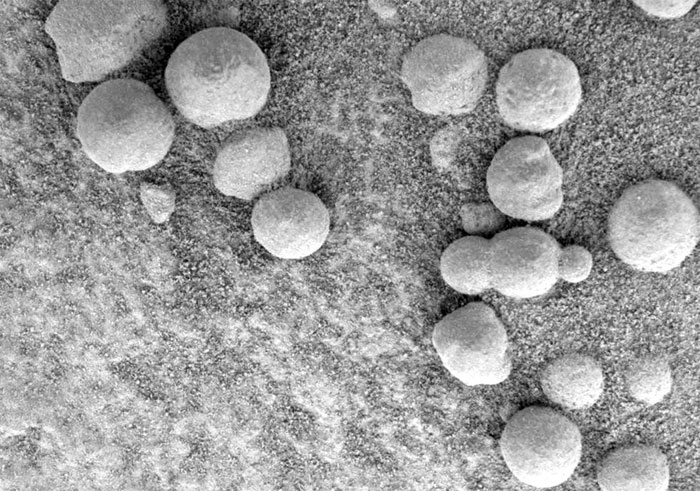.

Martian "Blueberries" Really Pieces of Meteorites?
The famed "blueberries" of Mars discovered by NASA rovers might just be asteroid impact debris.
.
The famed "blueberry" rocks discovered on Mars by NASA's Opportunity rover are not geological evidence of a history of ancient water on the red planet, a group of scientists now argue.
Instead, they propose that the tiny spherules are actually remnants of small meteorites that broke up in Mars's atmosphere. (See also "Mars Blueberries.")
In 2004, NASA’s Opportunity rover found countless gray-blue spherical rocks on Mars. Scientists proposed a number of theories—from volcanic eruptions to shockwaves caused by meteor impacts—to explain the tiny spheres (nicknamed blueberries by the discovery team), which contained large amounts of the iron-bearing mineral hematite.
The discovery team suggested that the blueberries formed when groundwater flowed through porous rocks, the way similar hematite-carrying spheres formed on Earth. The water flow sparks chemical reactions that cause the iron minerals to precipitate into small, layered balls.
When it was announced, this "concretion" model explaining the blueberries' formation seemed to solidify the case for water flowing on Mars in ancient eons.
In the journal Planetary and Space Science, however, planetary scientists at the University of Hawaii in Honolulu suggest that a meteorite model better explains various physical properties of the blueberries.
"None of the physical properties of the spherules match the concretion model," says geophysics researcher Anupam Misra, who led the study. "But the meteorite theory explains all of their properties."
Concretion vs. Meteorite
The biggest issue with the concretion model is that it cannot explain the narrow sizes of the Martian blueberries, Misra says.
On Mars, most of the hematite rocks are about 0.16 inches (4 millimeters) in diameter, and no larger than 0.24 inches (6.2 millimeters). By contrast, Earth spherules exhibit a large range of sizes, not limited to only a quarter of an inch.
These size differences make sense if the Mars rocks have a cosmic origin, Misra says. If a small meteorite hit Mars's atmosphere, it would break up into smaller pieces that would shower the surface of the planet. Just a few of these impacts could produce the many blueberries discovered on Mars. The researchers calculated that a meteorite 1.6 inches (4 centimeters) in diameter could scatter a thousand 0.16-inch spherules over a large area.
The scientists also suggest that the blueberries aren't as old as previously thought. According to the concretion model, the slow erosion processes that uncover hematite rocks would indicate that the blueberries are thousands of years old. But the apparent shininess of some of the Mars blueberries suggests they may be relatively young and haven't undergone much physical weathering.
A recent meteorite event would produce such shiny rocks, and could have impacted NASA's rovers. Images of the Opportunity and Spirit rovers show what appear to be micro-blueberries on top of the machines, as well as a circular burn mark from impact, Misra says.
A Controversial Claim
Not everyone agrees with the scientists' critique of the concretion model. "There are some pretty gross inaccuracies about what they're claiming," says Brenda Bowen, a geologist at the University of Utah who has studied concretions on Earth.
For one thing, the environment on Earth is very different from that of Mars. If the blueberries on Mars are concretions, their sizes would be limited by water availability, the size of pores in the sediment rock, and the reactants available in the environment, Bowen says.
Bowen also notes that the shininess of the rocks doesn't mean they're young. "When we look at deposits formed from hematite concretions on Earth, some are coated in dust, some in sand, and some are nicely polished," she says. "When the wind blows, you can get this kind of polishing from abrasion."
Sky Is Falling?
Though Bowen thinks the concretion theory is correct, she doesn't rule out the possibility of a meteorite explanation for at least some of the blueberries.
However, Timothy Glotch does.
"These spherules didn't form from some kind of high-temperature event, as you would expect from something melting in the Martian atmosphere," says Glotch, a geoscientist at Stony Brook University in New York.
Analysis of the blueberries using tools onboard Opportunity suggests the spherules formed from a low-temperature process, he says, adding that the resolution of the supposed rover-impact images is too low to definitively identify micro-blueberries or impact burns.
Whatever the case, a cosmic origin for the Mars blueberries wouldn't significantly change our understanding of the red planet, since other evidence points to a watery past for Mars, Misra says. But it would suggest that future scientific tools sent to Mars might need to be more robust to survive possible meteorite showers.
"If you are designing instruments to be used on Mars, those instruments need to be able to take impacts from small meteorites," Misra says.
Quelle: NG
5504 Views
